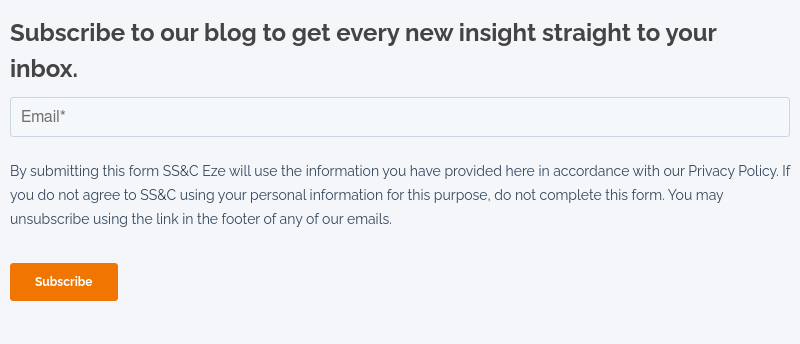Financial technology has a history of rapidly evolving to meet the shifting demands of the investment industry.
Take the Order Management System (OMS), for example. What began as a tool for tracking orders taken over the phone has transformed into a robust system that manages the entire lifecycle of orders and trades.
Similarly, the Execution Management System (EMS) was initially developed to help sell-side brokers and day traders navigate the fast-evolving electronic marketplace. Buy-side interest in the EMS surged when vendors began offering global, multi-asset platforms, and it has been growing ever since.
Today, investment technology continues to evolve to meet the mounting challenges firms face. According to research from Deloitte, in 2025, investment firms’ key priorities will include growing revenue, streamlining operations, and managing risks.
With over 15 years of experience advising firms on investment management solutions, I know about technological evolution. In this post, I leverage my expertise to outline the critical functionalities of OMS, EMS, and Order and Execution Management System (OEMS).
Understanding how each technology is positioned to help you navigate the challenges and opportunities facing today’s markets will give you the knowledge and confidence you need to make the right front-office technology decisions for your firm.

What is an Order Management System?
The OMS, typically used by investment managers, is principally concerned with front- and middle-office functions. OMS technology streamlines daily investment activity by automating allocations and providing position-checking and advanced compliance capabilities.
To support the demands of today’s investment firms, a modern OMS offers capabilities like portfolio modeling, the ability to view P&L and exposures, order routing, and decision support, in addition to trade execution analytics functionality. And while early OMSs focused on equities, today, the OMS supports firms’ ever-expanding arrays of asset classes.
As the hub of your investment activity, your OMS must be configurable and flexible. If the trade generation process is clunky and inefficient, it wastes valuable time and puts you at a higher risk for errors and missed opportunities.
Finally, your OMS platform must be able to grow and scale with you as your needs change – and they most certainly will. Without that scalability, you may be forced to pay for expensive upgrades, custom enhancements, or system replacements. And the total cost of ownership of your solution will outpace any savings you thought a more “affordable” option could provide.
What is an Execution Management System?
The primary goal of the EMS is to execute trades quickly. It is your firm’s direct connection to the market, designed to deliver fast and seamless access to global liquidity and provide traders with more complex execution options than the OMS can offer – the tools they need to help achieve best execution.
You’ll want to look for a system that offers automated trading capabilities, like rules-based order routing and advanced order types, such as conditional orders, list trading, and multi-leg orders.
In addition, today’s EMSs provide traders with more in-depth, real-time market data and insights. They can also generate fast, accurate execution reports and Transaction Cost Analysis (TCA).
In fast-moving markets with high volumes, compliance often becomes even more challenging. A good EMS integrates compliance into every stage of your workflow to keep your trades flowing without fear of noncompliance.
Trends in Investment Management: The Power of the OEMS
OMS and EMS technologies continue to serve as the core of the investment workflow and have evolved to keep pace with new challenges facing firms: increasing adoption of global multi-asset strategies, changing regulatory and compliance requirements, and increased operational risk.
For many firms, the best way to combat these challenges is to combine the OMS and the EMS into one OEMS sharing a single, centralized source of truth. One mistake I see firms make is selecting an OMS provider that does not offer the integrated, advanced EMS functionality they need. Having to tack on a third-party EMS can lead to clunky, FIX-only workflows and increased overhead.
An effective OEMS requires a code-level integration that fully synchronizes the data between the two systems. Connecting the systems at the source code empowers users with a single elegant solution combining all the traditional features and functionality associated with the OMS and EMS without needing to swivel back and forth between screens.
Relying on one OEMS offers firms a host of benefits across trading, compliance, technology, and operations departments, including more streamlined workflows and reduced cost and risk.
Getting the Service You Deserve
No matter what technology you choose – OMS, EMS, or OEMS – be sure it comes with dependable service and support.
Make sure your vendor's service team has the investment, size, and tenure needed to provide you with the service you need when you need it. Look for a team with experience supporting firms of similar sizes, strategies, and challenges.
And, when a problem arises, be sure that someone will be available to answer your call promptly and that they will be familiar with you, the nature of your business, and your history with the technology. You don’t want to waste time being bounced from one service rep to another.
Also, ask your technology vendor whether service is included or separate from your technology cost. If it is separate, you may be stuck with unexpected or "hidden" fees, which can increase your total cost of ownership.
A Trusted Technology Partner Investment Firms Can Growth With
Whether firms choose SS&C’s OMS, EMS, or OEMS, the efficiency and accuracy created by these technologies – combined with SS&C’s industry-leading support and service – do more than enhance operations: they give investment firms greater confidence in their ability to keep up with market challenges.
To achieve this level of confidence, investment firms need a technology vendor with the technical foundation, experience, and people they can count on – not just at the start but as the firm's needs evolve over time.
From trading and compliance to cost reduction and workflow optimization, SS&C's front-office solutions help users increase efficiency, decrease risk, and maintain compliance.
With over 35 years of experience, SS&C has been a reliable partner for firms looking to optimize their investment operations. Our solutions are not only designed to meet current needs but also to evolve with a firm’s growth, helping them to stay ahead in the market.
The company’s focus on R&D is unmatched, with over USD 110M dedicated to research and development efforts across SS&C's wealth and investment technology solutions annually.
Whether you are looking to buy, upgrade, or change front-office systems, SS&C’s Trading Technology Buyer’s Guide is your definitive resource for understanding how to apply the technical options available to you today to set your firm up for success in the future.


